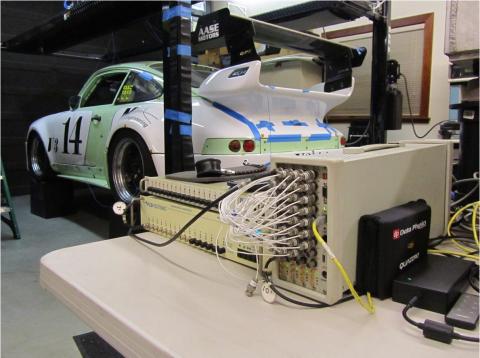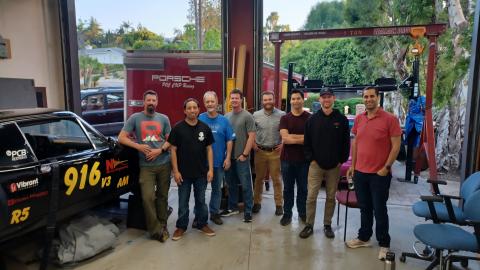Hands-On Modal Testing & Analysis Seminar
Mon-Thurs, Feb 24 - 27, 2025
Mon-Thurs, May 5 - 8, 2025
Mon-Thurs, Aug 11 - 14, 2025
Mon-Thurs, Nov 17 - 20, 2025
Seminar overview
Mon-Thurs, Feb 24 - 27, 2025
Mon-Thurs, May 5 - 8, 2025
Mon-Thurs, Aug 11 - 14, 2025
Mon-Thurs, Nov 17 - 20, 2025
Registration fee: $3,450
Background
The Navcon Hands-On Modal Testing & Analysis Seminar has been presented since 1992. Join the more than 1410 engineers and technicians who have tested a Navcon JimBeam and a fully race prepared Porsche. At the beginning of each year, we schedule three to four modal seminars. Depending upon the registration, additional seminars are added to the calendar.
It is our goal, that upon completing this 4-day, 40-hour intensive short course, attendees will be able to plan, setup and conduct a modal test from start to finish. This is a technology-based training about methods & applications; it is “not” a vendor product training. Modal theory is presented from the experimentalist’s point of view. Attendees acquire their own data and conduct their own analysis. There is no other modal testing seminar like this; it is truly a HANDS-ON training.
The modal seminar is intended for those engineers and technicians who (1) conduct modal and/or operational deflection shape (ODS) tests, (2) develop analytical (FE) or experimental (SDM) modal models and/or (3) are responsible for overseeing modal related projects. Applications include noise and vibration trouble shooting, ground vibration testing (GVTs), FE modal validation & updating and health monitoring projects among others.
Each class is limited to 10 attendees. Attendees are paired in groups of 2 and each group is provided a Data Physics based data acquisition system, PCB Piezotronics test instrumentation, Navcon test structures, etc. Everyone will have their own computer with MEscope Modal/ODS Testing software and FEMtools software for Modal Pretest Analysis, FEM-Test Correlation and FE Model Updating.
Hands-On Laboratories: More than 50% of the time is spent conducting lab exercises.
- Fourier Analysis, and Digital Signal Processing Labs
- JimBeam Impact Testing & Measurements Lab
- JimBeam Shaker Excitation Lab
- Porsche Multi-Channel Modal Test & Porsche Sine Dwell Forced Vibration Test
- Box Beam Shaker Modal Test, Time & Frequency Domain ODS Tests and FRF-ODS Test
- Modal Test Parameter Estimation Lab
- Modal Pretest Analysis, FEM-Test Correlation and FE Model Updating Labs
JimBeam Test Structure: JimBeam is a Navcon laboratory test structure constructed of three aluminum plates fastened together using six 10-24 bolts. JimBeam is used during several Navcon laboratories including the Impact Testing Lab, Shaker Excitation Lab, Impact Modal Test Lab, Structural Dynamics Modification Lab and FEM-Test Correlation & FE model Updating Lab. JimBeam served as the Round-Robin test article at IMAC XXVII in 2009 and for a study by NASA Kennedy Space Center correlating Free-Free and Shaker test models.
FEM-TEST Correlation lab

As shown above, the process includes a Simulation Side, a Test Side and links between simulation and test. During these labs attendee will create a finite element (FE) model of JimBeam, perform a dynamic analysis and calculate the FE modes. The “unvalidated” FE model will be used to conduct a Modal Pretest Analysis identifying optimal excitation and response locations for the modal test. Attendees will then conduct an impact modal test identifying the test modes. A FEM-Test Correlation will be performed using MAC and Orthogonality. Finally, the FE model will be updated to match the modal test results.
porsche modal lab

The Porsche modal is conducted on the second evening (~ 6:30 pm to 9:30 pm) and is a truly unique experience. The attendees develop the modal model geometry, acquire the modal data and animate the mode shapes. The evening culminates with a sine dwell test allowing the attendees to see and feel both the vehicle’s suspension and flexural modes and compare them with the animated mode shapes. Depending upon the race schedule, the Porsche modal is typically conducted on a race prepared 914-6 or a race prepared GT4 911. The first 914-6 modal test was conducted in 1977 at the University of Cincinnati. The 911 was first tested in 2010. The modal test data was used for the development of the roll cages and stiffening systems and for suspension tuning.
Seminar Schedule

1st day (Mon) 8:00 am to 6:00 pm – Includes Lunch
2nd day (Tues) 8:00 am to 9:30 pm – Includes Lunch & Dinner
3rd day (Wed) 8:00 am to 6:00 pm – Includes Lunch
4th day (Thurs) 8:00 am to 4:00 pm – Includes Lunch
Our Partners: The Hands-On Modal Testing & Analysis Seminar is a technology based training; it is “not” a manufacturer’s training. However, we do use the following hardware and software throughout the training.
- APS Dynamics: Long Stroke Modal Shakers
- Data Physics: Dynamic Signal Analyzers
- Dynamic Design Solutions: FEMtools FEM-Test Software
- PCB Piezotronics: Test Instrumentation
- Vibrant Technology: MEscope Modal & ODS Software

